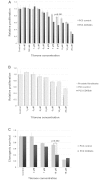Small-molecule screening of PC3 prostate cancer cells identifies tilorone dihydrochloride to selectively inhibit cell growth based on cyclin-dependent kinase 5 expression
- PMID: 24841903
- PMCID: PMC4067428
- DOI: 10.3892/or.2014.3174
Small-molecule screening of PC3 prostate cancer cells identifies tilorone dihydrochloride to selectively inhibit cell growth based on cyclin-dependent kinase 5 expression
Abstract
Cyclin-dependent kinase 5 (CDK5) is a potential target for prostate cancer treatment, the enzyme being essential for prostate tumor growth and formation of metastases. In the present study, we identified agents that target prostate cancer cells based on CDK5 expression. CDK5 activity was suppressed by transfection of PC3 prostate cancer cells with a dominant-negative construct (PC3 CDK5dn). PC3 CDK5dn and PC3 control cells were screened for compounds that selectively target cells based on CDK5 expression, utilizing the Johns Hopkins Drug Library. MTS proliferation, clonogenic and 3D growth assays were performed to validate the selected hits. Screening of 3,360 compounds identified rutilantin, ethacridine lactate and cetalkonium chloride as compounds that selectively target PC3 control cells and a tilorone analog as a selective inhibitor of PC3 CDK5dn cells. A PubMed literature study indicated that tilorone may have clinical use in patients. Validation experiments confirmed that tilorone treatment resulted in decreased PC3 cell growth and invasion; PC3 cells with inactive CDK5 were inhibited more effectively. Future studies are needed to unravel the mechanism of action of tilorone in CDK5 deficient prostate cancer cells and to test combination therapies with tilorone and a CDK5 inhibitor for its potential use in clinical practice.
Figures




References
-
- Siegel R, Ma J, Zou Z, Jemal A. Cancer statistics, 2014. CA Cancer J Clin. 2014;64:9–29. - PubMed
-
- Tarricone C, Dhavan R, Peng J, Areces LB, Tsai LH, Musacchio A. Structure and regulation of the CDK5-p25(nck5a) complex. Mol Cell. 2001;8:657–669. - PubMed
-
- Rosales JL, Lee KY. Extraneuronal roles of cyclin-dependent kinase 5. Bioessays. 2006;28:1023–1034. - PubMed
-
- Lalioti V, Pulido D, Sandoval IV. Cdk5, the multifunctional surveyor. Cell Cycle. 2010;9:284–311. - PubMed
-
- Dhavan R, Tsai LH. A decade of CDK5. Nat Rev Mol Cell Biol. 2001;2:749–759. - PubMed
Publication types
MeSH terms
Substances
Grants and funding
LinkOut - more resources
Full Text Sources
Other Literature Sources
Medical

